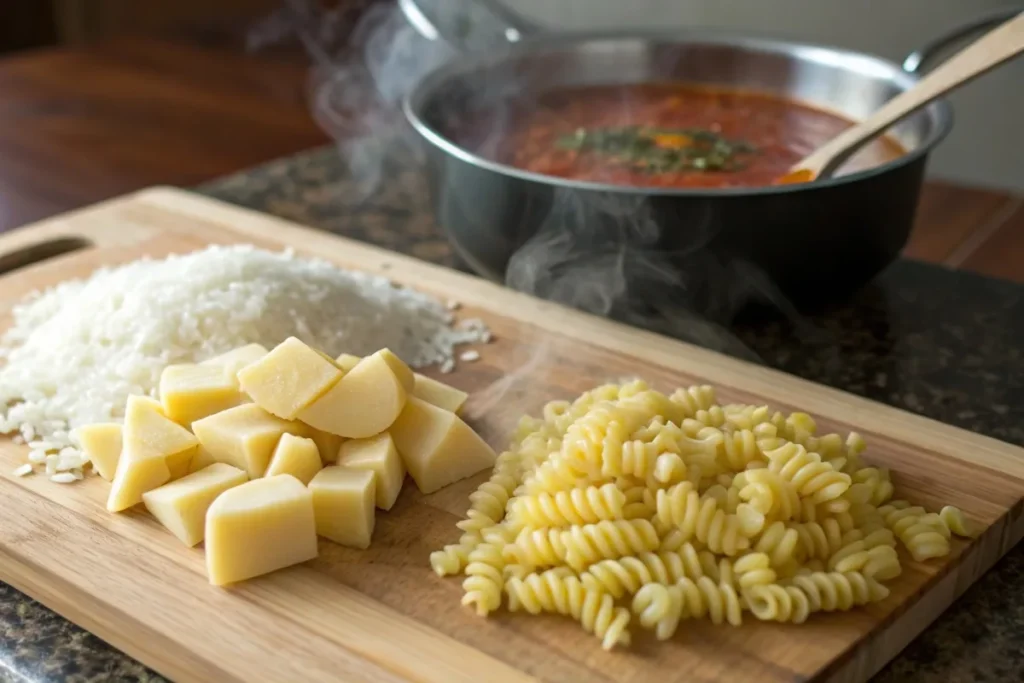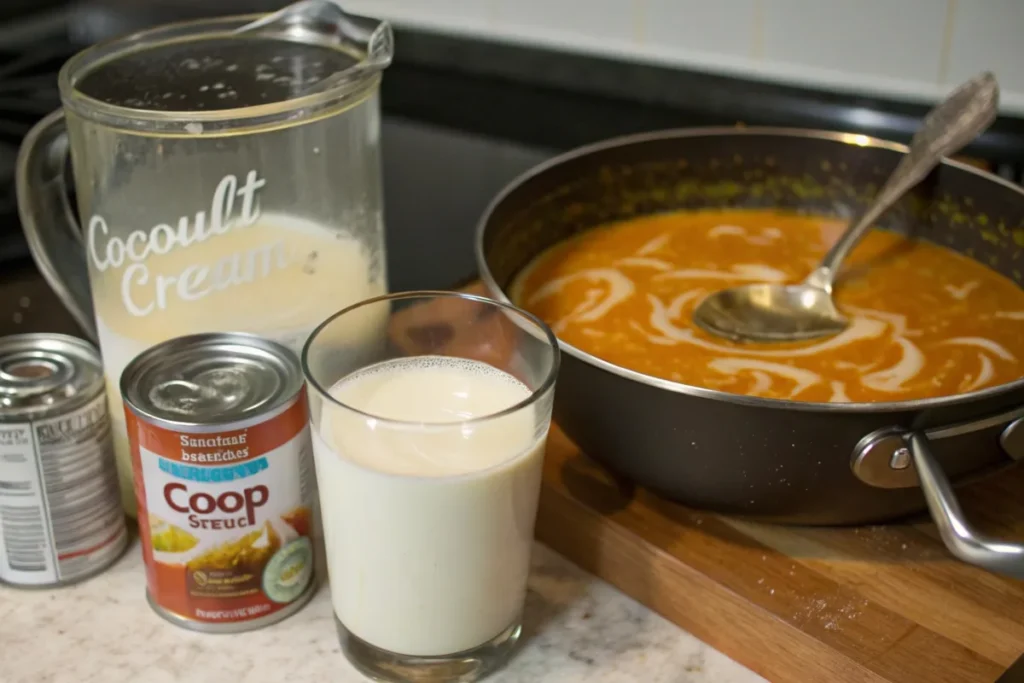How to make soup thick and creamy? It’s a question many home cooks ask when they crave a comforting, velvety bowl of goodness. Whether you’re preparing a hearty chowder or a silky bisque, achieving the perfect texture can transform an ordinary soup into something extraordinary. First, thick and creamy soups are not only delicious but also incredibly satisfying and versatile. Next, they’re simple to make with a few easy techniques and ingredients you probably already have in your kitchen. In addition, thick soups are perfect for cooler days or when you need a quick, hearty meal. Imagine dipping crusty bread into a luscious, creamy soup—pure comfort! Ready to learn how to elevate your soup game? Stick around for expert tips, tricks, and creative ideas that will help you create thick and creamy soups with ease. You’re going to love how simple and delicious this process can be!
Table of contents
- Easy Ways to Add Thickness to Your Soup
- Creamy Ingredients to Elevate Your Soup’s Texture
- Blending Techniques to Make Soup Smooth and Creamy
- Healthy Alternatives for Thick and Creamy Soups
- Expert Tips for Perfecting Thick and Creamy Soups
- Frequently Asked Questions (FAQs)
- Wrapping Up: Mastering the Art of Thick and Creamy Soups
Easy Ways to Add Thickness to Your Soup
Using Potatoes, Rice, or Pasta for Natural Thickness
Potatoes, rice, and pasta are fantastic ingredients for naturally thickening soups. First, diced potatoes release starch as they cook, making the broth creamy. Then, mashed or blended potatoes create a silky texture that’s hearty and satisfying. Next, rice works similarly; it softens in the soup, adding body without altering the flavor. For pasta, choose small shapes that absorb the broth while releasing starch. In addition, these options are budget-friendly and versatile, perfect for customizing your recipe. Wondering how to make soup thick and creamy? These pantry staples offer a quick, simple way to achieve a rich, delicious texture.

Adding Flour or Cornstarch for a Quick Fix
Flour and cornstarch are quick, reliable thickeners when your soup needs an instant boost. First, create a slurry by mixing flour or cornstarch with cold water. Then, stir the mixture into your simmering soup, watching as it thickens before your eyes. This method ensures no lumps while enhancing the soup’s consistency. In addition, cornstarch is gluten-free, making it a great option for everyone. With minimal effort, you’ll have a thicker, creamier soup in minutes. If you’re exploring how to make soup thick and creamy, these ingredients are kitchen lifesavers for busy days.
Creamy Ingredients to Elevate Your Soup’s Texture
Using Cream, Milk, or Coconut Milk for Richness
Cream, milk, or coconut milk can transform a basic soup into a luxurious dish. First, heavy cream adds richness and depth, perfect for chowders or bisques. Next, milk offers a lighter option, keeping the soup creamy without being too heavy. For a dairy-free alternative, coconut milk delivers a smooth texture and subtle tropical flavor. Simply stir your chosen liquid into the soup during the final stages of cooking. In addition, these ingredients blend seamlessly, creating a velvety finish. How to make soup thick and creamy? Add these rich liquids for an indulgent, satisfying result.

Incorporating Cheese or Yogurt for Extra Creaminess
Cheese and yogurt are delicious ways to make your soup thick and creamy. First, shredded cheese melts beautifully, adding both flavor and body. Then, plain yogurt, especially Greek yogurt, provides creaminess with a tangy twist. Stir these ingredients in slowly to avoid curdling and ensure a smooth texture. In addition, they enhance the soup’s nutritional value, offering calcium and protein. From cheddar to parmesan, or even a dollop of yogurt, these additions make every spoonful delightful. If you’re asking how to make soup thick and creamy, cheese and yogurt are flavorful answers!
Blending Techniques to Make Soup Smooth and Creamy
Using an Immersion Blender for Perfect Consistency
An immersion blender is a game-changer for achieving perfectly creamy soups. First, use it directly in the pot to blend the ingredients to your desired consistency. This technique is quick, easy, and eliminates the need for transferring hot soup to a blender. Next, you can control how smooth or chunky the soup becomes, offering flexibility for every recipe. In addition, blending releases the natural starches of ingredients like potatoes or beans, thickening the soup naturally. How to make soup thick and creamy? Grab your immersion blender and enjoy effortless results!
Combining Blended and Chunky Soup for Texture Variety
Blending only a portion of your soup can create the perfect balance of creamy and chunky textures. First, remove a portion of the soup and blend it until smooth. Then, return it to the pot, mixing it with the unblended portion. This method thickens the soup while retaining satisfying bites of vegetables, meat, or grains. In addition, it’s a great way to showcase the ingredients while enhancing the soup’s overall richness. Wondering how to make soup thick and creamy without losing texture? Partial blending offers the best of both worlds!
Healthy Alternatives for Thick and Creamy Soups
Thickening with Pureed Vegetables or Beans
Pureed vegetables and beans are healthy, natural ways to thicken soups without adding heavy ingredients. First, cook your chosen vegetables, like carrots, sweet potatoes, or cauliflower, until tender. Then, blend them into a smooth puree and stir them into the soup. Similarly, beans like cannellini or chickpeas create a creamy base when pureed. In addition, these options are packed with fiber and nutrients, making your soup both hearty and healthy. How to make soup thick and creamy without extra calories? Try these wholesome, plant-based thickeners!

Adding Nut Butter or Avocado for a Healthy Boost
Nut butter and avocado are unexpected yet effective ways to make your soup thick and creamy. First, stir a spoonful of almond or peanut butter into the broth for a rich, nutty flavor. Then, mash or blend avocado for a silky, luxurious texture. These ingredients add healthy fats and nutrients, enhancing the soup’s flavor and consistency. In addition, they’re excellent for creating unique, creamy soups that stand out. Wondering how to make soup thick and creamy in a healthy way? These superfoods are creative and nutritious solutions!
Expert Tips for Perfecting Thick and Creamy Soups
Balancing Flavors and Textures Like a Pro
Creating a thick and creamy soup isn’t just about texture; it’s also about balance. First, taste as you go to ensure the flavors shine through. Then, adjust seasonings like salt, pepper, or herbs to complement the soup’s creaminess. In addition, balance textures by combining creamy bases with hearty ingredients like vegetables or grains. Don’t forget to garnish with fresh herbs or a drizzle of olive oil for added appeal. How to make soup thick and creamy? Master the art of balance for truly professional results!
Avoiding Common Mistakes in Soup Preparation
Avoiding common mistakes is key to making thick and creamy soups. First, add thickeners gradually to prevent over-thickening. Next, stir constantly to avoid lumps when using flour or cornstarch. In addition, avoid adding cream or yogurt at high heat to prevent curdling. Use fresh, high-quality ingredients for the best flavor and consistency. Finally, don’t forget to blend carefully to achieve your desired texture. Wondering how to make soup thick and creamy without frustration? Follow these tips to perfect your soup every time!
Frequently Asked Questions (FAQs)
How do you increase soup thickness?
Increasing soup thickness is easy with a few simple tricks! First, add starchy ingredients like potatoes, rice, or pasta. These release natural starches as they cook, thickening the broth. Next, create a slurry by mixing flour or cornstarch with cold water, then stir it into the soup. You can also blend a portion of the soup to make it smoother while keeping some chunks for texture. Another option is to use creamy ingredients like milk, cream, or yogurt. Wondering how to make soup thick and creamy? These methods are quick and effective for any recipe!
What is the best cream to thicken soup?
The best cream for thickening soup depends on the richness you want. Heavy cream is a top choice for its luxurious texture and flavor. First, add it during the final stages of cooking to avoid curdling. Next, light cream or half-and-half offers a lighter option while still adding creaminess. Coconut milk works wonderfully for dairy-free soups, delivering a smooth texture and subtle sweetness. In addition, you can experiment with different types of cream to suit your recipe. How to make soup thick and creamy? Choose the perfect cream to complement your dish!
What are the 4 ways to thicken a sauce or soup?
There are four easy ways to thicken a sauce or soup. First, use a roux by cooking equal parts butter and flour before adding it to your soup. Next, mix cornstarch or flour with water to create a slurry for quick thickening. You can also puree ingredients like vegetables or beans to add body while enhancing flavor. Finally, add creamy elements like heavy cream, yogurt, or cheese for richness. In addition, each method works well with different recipes, so you can choose the best fit. How to make soup thick and creamy? These four techniques offer foolproof results!
What makes soup so thick?
Soup becomes thick thanks to the ingredients and techniques used. Starches like potatoes, rice, or pasta release natural thickeners during cooking. Blending a portion of the soup creates a smooth texture, while leaving chunks adds heartiness. Creamy additions like heavy cream, coconut milk, or cheese make soups luxuriously thick. Pureed vegetables or beans also contribute to a velvety consistency. In addition, thickeners like flour or cornstarch add instant results. How to make soup thick and creamy? Combine these methods for a bowl of perfectly textured, delicious soup every time!
Wrapping Up: Mastering the Art of Thick and Creamy Soups
How to make soup thick and creamy? The answer lies in the variety of simple, effective techniques you’ve just discovered. From using starchy ingredients like potatoes and rice to adding luxurious cream or coconut milk, each method brings something unique to the table. First, experiment with blending, pureeing, or adding thickeners like flour or cornstarch. Then, try healthy alternatives like pureed vegetables or avocado for a nutritious twist. In addition, balance flavors and textures to create soups that are both satisfying and delicious. Making thick and creamy soup doesn’t have to be complicated—it’s all about finding what works best for you. So, gather your ingredients, have fun in the kitchen, and enjoy creating soups that are as comforting as they are flavorful. With these tips, you’re ready to transform any soup into a masterpiece. You’ve got this—happy cooking!
